The Steller’s Jay is a large songbird. They have chunky bodies, large heads, long, full tails, and rounded wings. They’re graceful flyers and fly with long swoops on their wings.
These birds inhabit the evergreen forests of the West. However, these birds also inhabit other areas, like parklands, backyards, and campgrounds.
The Steller’s Jay will stick to tall tree canopies, but they can be easy to spot thanks to their scolding and harsh calls.
On this page
Breeding Male
From a distance, Steller’s Jays look very dark. They lack the white underparts that most other Jays have. Instead, their bodies are all blue, with the lightest coloring on the wings.
Their heads are charcoal black, with white markings above the eye. These birds are 11.8 to 13.4 inches (30 to 34 centimeters) long and weigh 3.5 to 4.9 ounces (100 to 140 grams). These birds are about the same size as a Western Scrubjay.
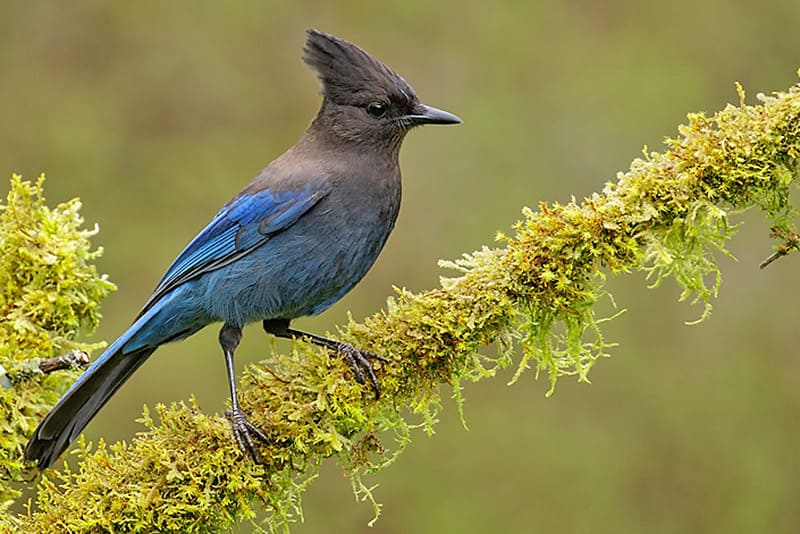
Photograph © Glenn Bartley.
Female
Female Steller’s Jays look identical to male Steller’s Jays.
Juvenile
Like the females, juvenile Stellar’s Jays look identical to breeding male Stellar’s Jays, except they are paler gray and have a smaller crest. On average, it takes 16 days for Stellar’s Jays to hatch. After that, juvenile Stellar’s Jays stay with their parents for 2 to 3 months while they learn to fly and grow their feathers.
There are 16 identified subspecies of the Steller’s Jay in Central and North America. These subspecies have varying combinations of blue and black on the body, head, and crest.
The Queen Charlotte Islands, near British Columbia, is home to the darkest, largest race.
In North America, differences are notable, especially between the lighter Rocky Mountain forms with partial white eyerings and white streaks and the darker Pacific forms that have blue streaks over the eye.
Habitat
Steller’s Jays inhabit coniferous-deciduous and coniferous forests. You can find these birds at lower levels of the Pacific coastal foothills in evergreen forests and at elevations of 3,000 to 10,000 feet in the wilderness.
In some winters, flocks of Stellar’s Jays will sometimes move through abnormal habitats like the Sonoran desert.
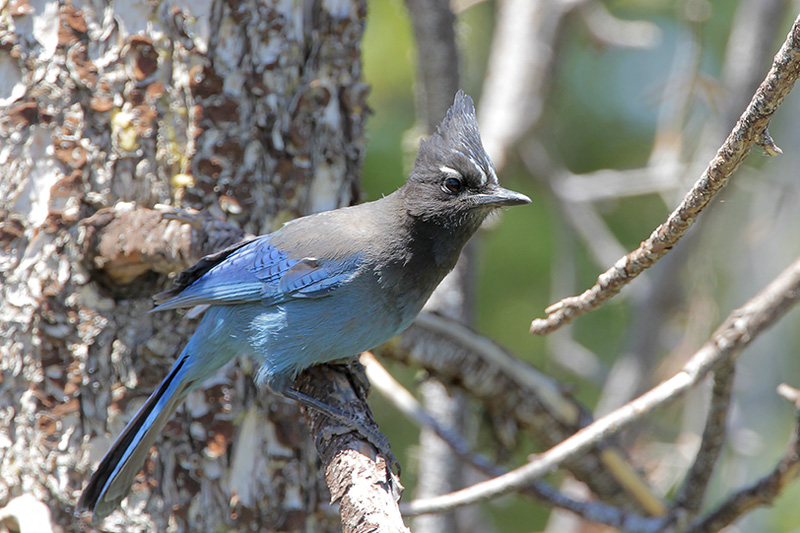
Pluamge can vary by location, some have more white on the face. Photograph © Greg Lavaty.
Diet
Steller’s Jays are foragers. They have a braid diet that consists of seeds, insects, berries, small animals, nuts, nestlings, and eggs. In human habitats, these birds will steal food from unguarded picnic tables, consume garbage, and visit bird feeders with sunflower seeds, suet, and peanuts.
Pinyon pine seeds and acorns are common foods for Steller’s Jays to bury for the winter. They’ll carry several of these large nuts in their throat and mouth. In addition, Steller’s Jays are opportunistic feeders. They’ll look for handouts from people and will steal food from other birds.
Behavior
Steller’s Jays tend to hop around on their long legs both on the main branches of conifer trees and on the ground. They often stop to observe their surroundings; you’ll see them cock their head and move it often.
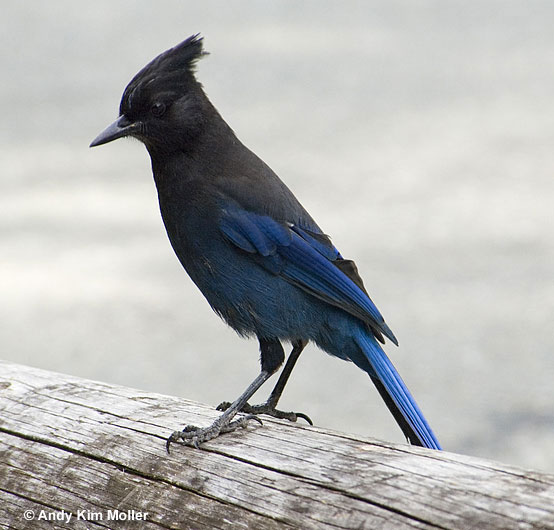
Jays have amazing spatial memories, which is what allows them to store a surplus amount of food for the winter.
These birds are known nest predators; they’ll steal different bird species’ chicks and eggs from the nests.
Steller’s Jays are very social birds; they often travel in groups and play together. It’s also not uncommon to see them in mixed-species flocks. They’re one of the most vocal species of birds in mountainous forests and are known to instigate the mobbing of predators.
Range (and seasonal changes)
Steller’s Jays are year-round residents. Birds that breed in higher elevations will move to lower elevations for the winter. You can find these birds at lower levels of the Pacific coastal foothills in evergreen forests and at elevations of 3,000 to 10,000 feet in the wilderness. In Mexico and the Southwestern portion of the U.S., they live in dry pine-oak woodland.
Wing shape
Steller’s Jays have a wingspan of 17.3 inches (44 centimeters). These birds have rounded, broad wings and are graceful yet lazy flyers. Steller’s Jays fly with long swoops.
Fun Facts
- Steller’s Jays are named after Georg Steller. He was the first European naturalist to describe a number of plants and animals in North America.
- Blue and Steller’s Jays are the only jays in North America to have crests. The Blue Jay continues to expand into the western portions of North America. Their range is starting to overlap with the Steller’s Jays. These two species occasionally meet, interbreed, and produce hybrids.
- Steller’s Jays are very loud birds, both day and night. However, they’re very quiet during the breeding season, so they don’t attract attention to them or their nests.
- The Stellar’s Jay symbolizes self-appreciation, fulfilling your calling, and love. Seeing one is a message from spirits to follow through.
Vocalization
Steller’s Jays are known for their repeated and loud “shook shook shook shook” call. They make this call during aggressive interactions, while perched, and in flight. They also make a variety of harsh, nasal-sounding growls and guttural sounds.
These birds have also been known to mimic a wide variety of sounds, including Northern Flickers, squirrels, Northern Goshawks, mechanical sounds like water sprinklers, and White-breasted Nuthatches.
In addition, male Steller’s Jays and sometimes females will sing quietly involving whistles, popping sounds, and gurgles that they string together. This is commonly heard during courtship.
Similar Species
Here are some bird species that look similar to Steller’s Jays.
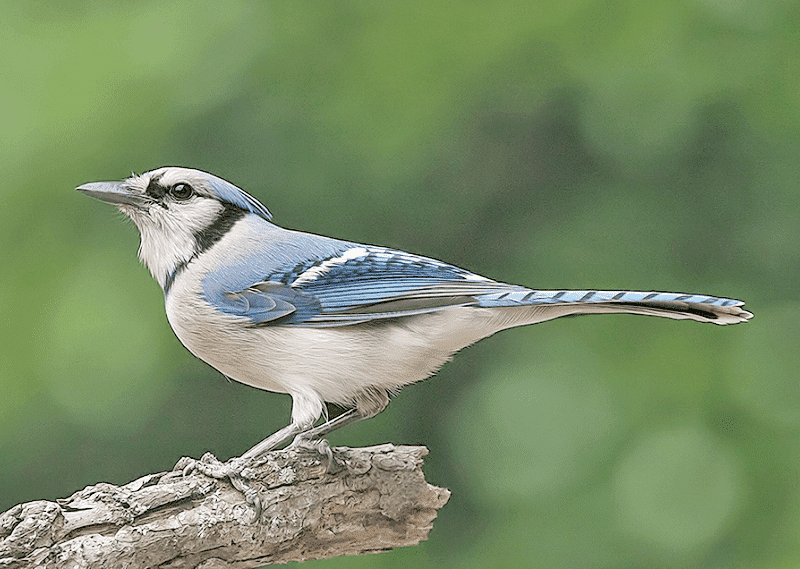
Blue Jay. Photograph © Alan Wilson.
Overall, Blue Jays tend to be lighter-colored than Steller’s Jays. But still, they share the same characteristics.
Blue Jays have light blue plumage with a white underbelly and some black on their neck, wings, and tails, whereas Steller’s Jays have dark blue and black plumage.
The two have some overlap in their ranges.
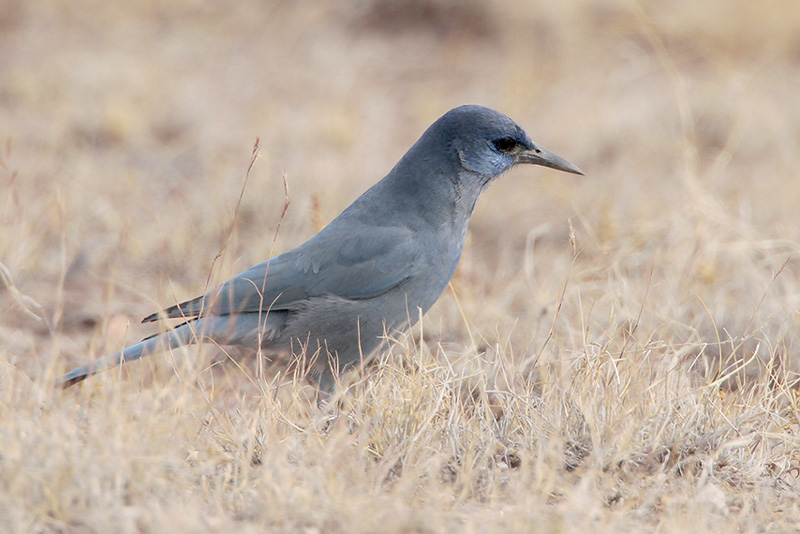
Pinyon Jay
Although they look similar, some key differences exist between Pinyon Jays and Steller’s Jay.
Pinyon Jays do not have a crest on their heads. They also lack the darker parts that make the Stellar Jay easily identifiable.
Frequently Asked Questions
Are Steller’s Jays rare?
No, the Steller’s Jay is not rare. These birds have a decent range and a stable population.
What’s the difference between a Blue Jay and a Stellar Jay?
Steller’s Jays have a black underbelly and face, while Blue Jays have a white underbelly and face. Additionally, Steller’s Jays have black and blue feathers, while Blue Jays have blue, black, gray, and white feathers.
Do Steller Jays go south for the winter?
No, Steller’s Jays do not go south for the winter. They’re year-round residents; however, they do travel to lower elevations during the winter.
What is the lifespan of a Steller’s Jay?
The lifespan of a Steller’s Jay is about 10 years. However, the oldest Steller Jay lived to be 16.

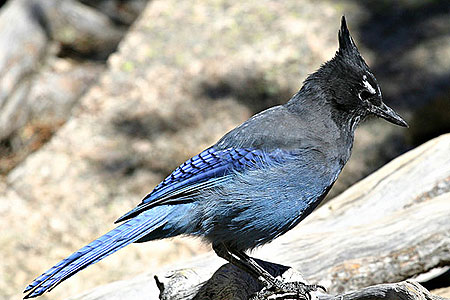

Renee
Wednesday 15th of November 2023
I have been feeding chickadees and nuthatches at my home in central idaho. One steller jay came last winter, then he brought his mate and now 3 of this years babies. they are cool birds but scare all the other birds away. they steal all the seeds for themselves. Would you have any suggestions for feeders they can not get at how to keep them away.
Patrick O'Donnell
Thursday 16th of November 2023
@Renee- How nice to have those birds in your backyard! Sometimes, Steller's Jays can be a challenge. One idea is putting out another feeder or two engineered for small birds. You might find some ideas at these posts: https://www.birdzilla.com/learn/best-squirrel-proof-bird-feeders/ https://www.birdzilla.com/in-the-backyard/attracting-birds/feeders/window-mounted-feeders/